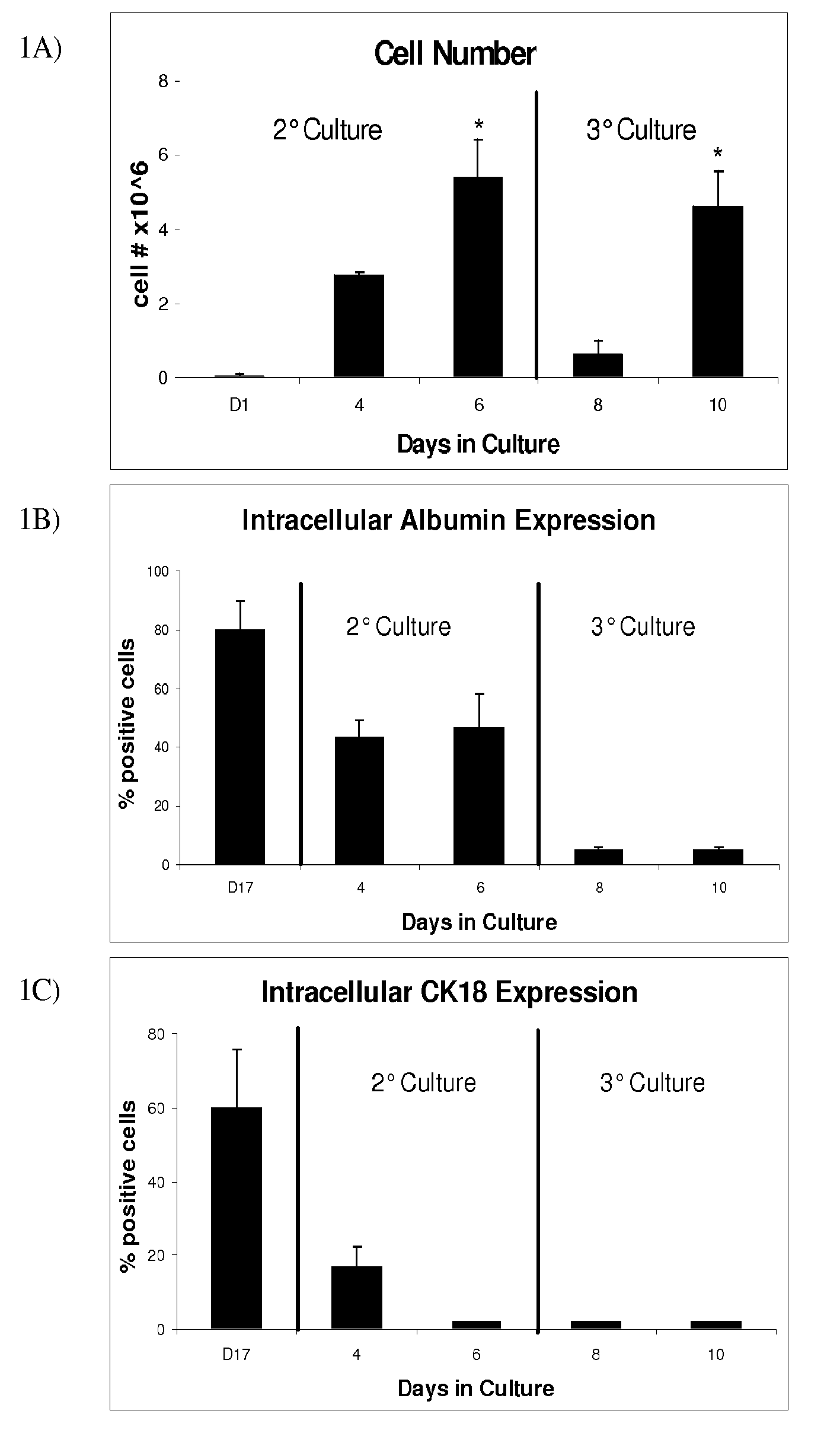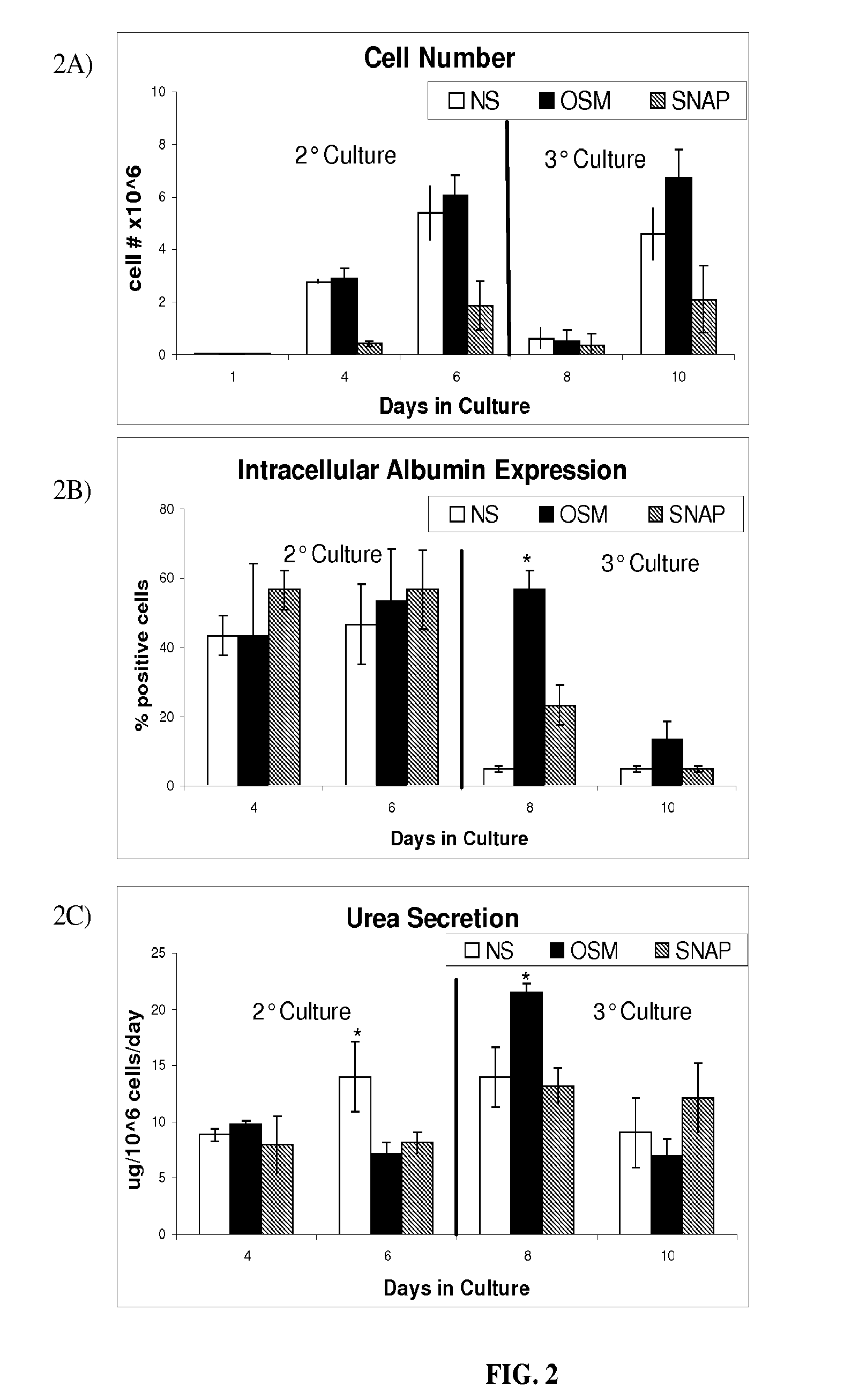System and method for liver cell culture and maturation
a liver cell and system technology, applied in the field of systems and methods for maturation, proliferation and maintenance of function in hepatocytes, can solve the problems of insufficient cell proliferation, limited technology, and inability to generate large and functionally sustainable cell masses, and achieve the effect of reducing the number of patients and reducing the number of deaths
- Summary
- Abstract
- Description
- Claims
- Application Information
AI Technical Summary
Benefits of technology
Problems solved by technology
Method used
Image
Examples
example 1
Cell Cultures
[0041]All cell cultures were incubated in a humidified 37° C., 5% CO2 environment. The ES cell line D3 (ATCC, Manassas, Va.) was maintained in an undifferentiated state in T-75 gelatin-coated flasks (Biocoat, BD-Biosciences, Bedford, Mass.) in Knockout Dulbecco's modified Eagles medium (Gibco, Grand Island, N.Y.) containing 15% knockout serum (Gibco), 4 mM L-glutamine (Gibco), 100 U / ml penicillin (Gibco), 100 U / ml streptomycin (Gibco), 10 ug / ml gentamicin (Gibco), 1000 U / ml ESGRO™ (Chemicon, Temecula, Calif.), 0.1 mM 2-mercaptoethanol (Sigma-Aldrich, St. Louis, Mo.). ESGRO™ contains leukemia inhibitory factor (LIF), which prevents embryonic stem cell differentiation. Every 2 days, media was aspirated and replaced with fresh media. Cultures were split and passaged every 6 days, following media aspiration and washing with 6 ml of phosphate buffered solution (PBS) (Gibco). Cells were detached following incubation with 3 ml of trypsin (Gibco) for three minutes, resulting in...
example 2
In Situ Indirect Immunofluorescent Cytokeratin-18 and Intracellular Albumin Analysis
[0045]After 24 hours in culture and fixing with 4% paraformaldehyde, the cells were then washed for 10 min in cold PBS and fixed in 4% paraformaldehyde (Sigma-Aldrich) in PBS for 15 minutes at room temperature. The cells were washed twice for 10 min in cold PBS and then twice for 10 min in cold saponine / PBS (SAP) membrane permeabilization buffer containing 1% bovine serum albumin (BSA) (Sigma-Aldrich), 0.5% saponine (Sigma-Aldrich) and 0.1% sodium azide (Sigma-Aldrich). To detect intracellular albumin, the cells were subsequently incubated for 30 minutes at 4° C. in a SAP solution containing rabbit anti-mouse albumin antibody (150 ug / ml) (MP Biomedicals, Irvine, Calif.), or normal rabbit serum (150 ug / ml) (MP Biomedicals) as an isotype control, washed twice for 10 min in cold SAP buffer, and then treated for 30 minutes at 4° C. with the secondary antibody, FITC-conjugated donkey anti-rabbit, diluted ...
example 3
Sandwich ELISA for Detection of Albumin Secretion
[0046]In order to detect secreted albumin within the media supernatants obtained on each of the analysis days, we used a commercially available mouse albumin ELISA kit (Bethyl Laboratories, #E90-134). A standard curve was generated by creating serial dilutions of an albumin standard from 7.8 to 10,000 ng / mL. Absorbance readings were obtained using a Biorad (Hercules, Calif.) Model 680 plate reader with a 450 nm emission filter. Albumin values were normalized to the cell number recorded on the day of media sample collection.
PUM
| Property | Measurement | Unit |
|---|---|---|
| concentration | aaaaa | aaaaa |
| incubation time | aaaaa | aaaaa |
| time | aaaaa | aaaaa |
Abstract
Description
Claims
Application Information
 Login to View More
Login to View More - R&D
- Intellectual Property
- Life Sciences
- Materials
- Tech Scout
- Unparalleled Data Quality
- Higher Quality Content
- 60% Fewer Hallucinations
Browse by: Latest US Patents, China's latest patents, Technical Efficacy Thesaurus, Application Domain, Technology Topic, Popular Technical Reports.
© 2025 PatSnap. All rights reserved.Legal|Privacy policy|Modern Slavery Act Transparency Statement|Sitemap|About US| Contact US: help@patsnap.com



